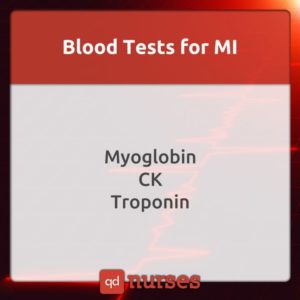1. Blood Tests for MI.

A heart attack, also called an acute myocardial infarct, is caused by a blockage in the heart’s arteries that completely cuts off the blood supply to a portion of the heart.
Signs and symptoms of an acute myocardial infarction include chest pain, rapid pulse, nausea and vomiting, sweating, sudden onset of shortness of breath, difficulty breathing, and change in blood pressure.
Also Read: Laboratory Values and Interpretation – A Nurse’s Ultimate Guide
To confirm a myocardial infarction, tests will be necessary. These tests include an electrocardiogram (ECG) and blood tests such as Myoglobin, CK and Troponin. Additional tests may also be required such as a chest X-ray, echocardiogram, coronary catheterization (angiogram), exercise stress test, and cardiac computerized tomography (CT) or magnetic resonance imaging (MRI).
2. Blood Type.

The four major blood groups are types A, B, AB, and O. Type O negative blood is considered the “universal donor” because it can be donated to people of any blood type. Type AB positive blood, on the other hand, is considered the “universal recipient” because people with this type can receive any blood type.
3. Blood Urea Nitrogen (BUN) Test.

A BUN test can reveal whether your urea nitrogen levels are higher than normal, suggesting that your kidneys or liver may not be working properly.
Also Read: 10 Nursing Mnemonics & Tricks – Diagnostic Exams
If kidney problems are the main concern, the blood is tested for urea nitrogen and creatinine levels. Creatinine is another waste product that healthy kidneys filter out of your body through urine. High levels of creatinine may be a sign of kidney damage.
4. Diagnostic Test for Cystic Fibrosis.

Cystic fibrosis is diagnosed based on the results of a number of tests which include newborn screening, wherein newborns are tested for CF using a genetic or a blood test. Another diagnostic procedure is sweat test which measures the amount of salt in sweat. Other tests are carrier testing and prenatal screening among others.
5. Guthrie Test.

The Guthrie test is a blood test carried out on newborns to detect a disorder call phenylketonuria.
Phenylketonuria (PKU) is a genetic disorder in which the body cannot process part of a protein called phenylalanine. Treatment for PKU involves a low-protein diet.
6. Hematology Values.

Red blood cells are round with a flat, indented center, like doughnuts without a hole. They remove carbon dioxide from the body, transporting it to the lungs to be exhaled. In men, there are around 5,200,000 RBCs per cubic millimeter (microliter). Women, on the other hand, have around 4,600,000 RBCs per cubic millimeter.
White blood cells (also called leukocytes or immune cells) are part of the immune system which help to defend the body against infectious diseases and foreign materials. Normally, there are about 5,000 to 10,000 white blood cells per drop of healthy adult blood.
Also Read: 50 Nursing Mnemonics & Acronyms You Need To Know Now
Platelets or thrombocytes are the smallest cell type in the blood and are produced from bone marrow stem cells. Their function is to clog broken blood vessels to prevent the loss of blood. Normal levels range from 150,000 to 450,000 platelets per micro-liter of blood. A low platelet count may result from a condition called thrombocytopenia.
Hemoglobin is the protein molecule in red blood cells that carries oxygen from the lungs to the body’s tissues and returns carbon dioxide from the tissues back to the lungs. The iron contained in hemoglobin is also responsible for the red color of blood. Hemoglobin plays an important role in maintaining the shape of the red blood cells.
The normal ranges for hemoglobin depend on the age and, beginning in adolescence, the gender of the person. Normal ranges are 14 to 18 gm/dL for adult men, 12 to 16 gm/dL for adult women, 12.4 to 14.9 gm/dL for men after middle age, and 11.7 to 13.8 gm/dL for women after middle age.
7. Multiple Myeloma.

Multiple Myeloma is a cancer of plasma cells wherein abnormal cells multiply uncontrollably in the bone marrow and occasionally in other parts of the body.
Symptoms include bone pain, constipation, increased frequency of urination, weakness, confusion, anemia, repeated infections, and easy bruising or bleeding.
8. Schilling Test.

The Schilling test is used to determine whether or not the patient is absorbing Vitamin B12 properly. It is usually ordered by doctors in patients suffering from Vitamin B12 deficiency (pernicious anemia) to determine if the stomach is producing the intrinsic factor required for Vitamin B12 absorption.
See More:
1. Nursing Flashcards (Communicable Diseases)
2. Nursing Flashcards (NCLEX Tips/Psychiatric Nursing)
3. Nursing Flashcards (Fundamentals of Nursing)
4. Nursing Flashcards (Medical-Surgical Nursing)
5. Nursing Flashcards (Nutrition)
6. Nursing Flashcards (Obstetrics and Newborn Care)
7. Nursing Flashcards (Pediatric Nursing)
8. Nursing Flashcards (Pharmacology)



















